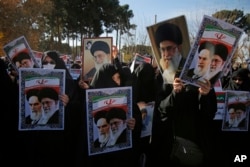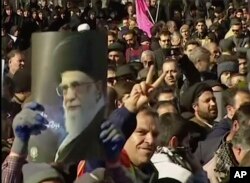Iranians reacted dismissively to a series of pro-government rallies held in the country Wednesday, saying they appeared to have been coerced, in contrast to the spontaneity of a weeklong anti-government protest movement that has posed the biggest domestic challenge to Iran's ruling clerics in eight years.
In the Wednesday edition of VOA Persian’s Straight Talk program, callers in Iran who said they witnessed the pro-government rallies told the hosts they believed the participants had joined largely under pressure from powerful institutions.
The callers said many of the pro-government demonstrators were teenage students sent to the rallies by schools. They said many of the others were military personnel in plainclothes and government employees fearful of losing their jobs if they did not participate.
A man who gave his name as Ahura, calling from the central city of Isfahan, told Straight Talk that Iranian authorities had staged the demonstration that he saw.
“They enticed people with cakes and sandwiches and threats that they would lose their jobs,” he said. “They brought in their puppets, the government mullahs, and called it a pro-government rally.”
Several other callers to VOA Persian shared similar perceptions of the pro-government rallies as having been orchestrated by the Iranian government, but the claims could not be independently verified.
Western media reported that thousands of government supporters joined Wednesday’s demonstrations. Iranian state media said the rallies were held in more than 10 cities around the country, including the Shiite religious center of Qom, and the western cities of Ahvaz and Kermanshah.
State television broadcast live footage of the daytime rallies, in which marchers waved Iranian flags and portraits of supreme leader Ayatollah Ali Khamenei and chanted slogans in support of Iran’s Islamist establishment. The state-run Press TV network said the marchers had gathered to condemn deadly violence that has erupted at some of the daily anti-government protests that began Dec. 28 and quickly spread nationwide.
The anti-government demonstrators mainly have been marching peacefully to protest the high cost of living and perceived government corruption. They also have called for an end to the rule of Iran’s Islamist clerics. Iranian state media have said at least 20 people have been killed in the protests, some of which escalated into street confrontations between demonstrators and security forces. But Iranian authorities have not publicly disclosed who or what caused the fatalities.
Messages sent by people in Iran to VOA Persian said anti-government activists rallied again in several towns on Wednesday, marking the seventh straight day of protests. One video sent from the northern Iranian town of Nowshahr showed demonstrators chanting, “Death to the dictator” — a common slogan of the recent protests, aimed at Khamenei. The messages also said Iranian security forces had increased their presence on the streets of various cities Wednesday, dissuading many people from joining further anti-government rallies.
In Wednesday’s Straight Talk program, some callers complained of a double standard, with the Iranian government permitting its supporters to march, while blocking and confronting its opponents who sought to do the same. A man who identified himself as Yasir in Tehran said, “Under the constitution, we have the right to demonstrate. Why is the government not letting people speak out.”
Iranian President Hassan Rouhani has responded to the protests by acknowledging the right of people to demonstrate and criticize his government. But Iranian officials also have vowed to stop what they see as a wave of violent attacks by saboteurs against government institutions.
VOA Persian's Mohammad Naficy, Behrooz Samadbeygi and Afshar Sigarchi and VOA correspondent Masood Farivar contributed to this report.










